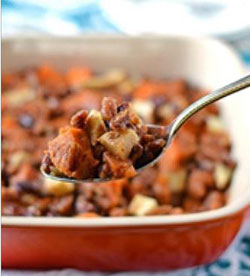Making comfort foods healthier
Anne Zander, Family & Consumer Sciences Extension Agent Boulder County

People tend to turn to comfort foods when the weather is cold and damp. We can all relate to the increase in cravings for sweet, salty, creamy and fatty foods!
A comfort food is any food or beverage that gives a comforting, satisfying feeling after you consume it. Many comfort foods are filled with artery-clogging fat, sugar, sodium (salt), and numerous extra ingredients.
Fortunately, it is possible to enjoy healthier versions of comfort foods. Choose hearty, homemade broth-based soups rather than cream-based soups. Choose sweet potatoes as an alternative to white potatoes to boost the nutrition.
Popular Comfort Foods
Macaroni & Cheese: Modify your recipe by using low-fat cheese and low-fat milk. Add vegetables to make it more nutritious like sliced tomatoes. Or, try whole-wheat elbow macaroni tossed with a cup of tomato sauce and 2 tablespoons of parmesan cheese (2 cups = 420 calories and 5 grams fat)
Chili & Stews: Chili and stews can be very hearty and high in protein. Use small portions of lean meat such as lean beef or turkey, lots of vegetables and beans, and then sprinkle a small amount of low-fat cheese on top. Limit high-fat ingredients like ground beef, sausage and cheese. Increase the proportion of vegetables, beans and legumes and reduce meat to increase fiber and reduce overall calories. Stews and soups become more delicious when refrigerated overnight to allow flavors to blend.
Cream & Cheese-based Casseroles: Creamed, scalloped, and au gratin dishes like hash brown potato casserole begin with healthy ingredients, such as potatoes, broccoli and green beans. However, the calories can quadruple when you add cream, butter, and canned soups and top them with cheese, bacon, onions, breadcrumbs, or buttered crackers. For a casserole, substitute low-calorie ingredients such as fat-free or low-fat sour cream, Greek yogurt, cheese and soups. Try oven-roasted vegetables, such as new potatoes, brussel sprouts, green beans, etc. in place of a casserole all together.
Cream-based Soups & Chowders: Soups and chowders loaded with cream are high in calories, fat and sodium, especially if you add salty crackers or a cheese topping. To reduce calories and fat, choose tomato-based or broth-based soups, like vegetable or minestrone. Enjoy soup as an appetizer or with a salad or a whole-wheat roll. Choose low-sodium canned soup or broths.
Sweet Potatoes or Yams: Enjoy a plain baked sweet potato or yam, and eat the skin. Sweet potatoes are a good source of beta-carotene, potassium, vitamin C and fiber.
Sweet Potato Fries: Instead of French fries, eat baked sweet potato fries. To make sweet potato fries, slice a sweet potato into small sticks and spread sticks on a baking sheet. Lightly coat with cooking spray, sprinkle with kosher salt or other seasonings, and bake at 375 °F for 25 minutes.
Candied Yams: Skip the traditional candied yams, which are high in sugar and saturated fat. Bake yams with a just a small amount of brown sugar, and replace the butter with orange juice or olive oil.
Chocolate: For an occasional treat, enjoy chocolate-dipped strawberries or other fruits. Fruits are a great source of fiber, vitamins, and minerals. Dark chocolate contains flavanol antioxidants, which are plant substances that may help reduce blood cholesterol levels. The most beneficial is dark chocolate that is at least 70% cocoa.
Baking: When baking, substitute applesauce or prune puree for half of the butter, shortening or oil that the recipe calls for. A half-cup of unsweetened applesauce has just 50 calories and barely any fat, compared with nearly 1,000 calories and more than 100 grams of fat in a half-cup of oil. Another idea: Just reduce the amount of sugar the recipe calls for by a third. Chances are you won’t notice the difference. When you cut back on fat in foods, they sometimes become bland in taste. Experiment with adding different spices and herbs until you get the desired flavor.
Let’s Talk:
Many traditions and memories are food-related, offering people a way to link past, present and future generations. Children helping with preparing, baking, and cooking family favorite foods can be family time well spent.
- Make sure everyone starts with clean hands.
- Let children help choose recipes
- Make sure the task for each child is appropriate for their age and skills. Counting measures of flour can get the smallest child involved.
- Have paper towels ready to wipe up spills.
- Supervise use of knives and oven carefully.
- Be patient. Don’t get upset if the end product isn’t exactly like you might have made. Remember, the important thing is for the family to spend time together.
Resource: Winter 2015 Better Kid Care, Penn State
Recipe for Health:

Baked Apples & Sweet Potatoes
Here is a recipe that is sure to be a favorite, even with children. Other recipes are available at
https://www.facebook.com/LiveEatPlay
Ingredients:
2 cups baking apples
2 cups sweet potatoes
½ cup apple cider
¼ teaspoon salt
¾ teaspoon cinnamon
½ teaspoon nutmeg
¼ teaspoon ginger
1 tablespoon butter, melted
¼ cup brown sugar, firmly packed
Directions:
Peel, core and cut apples into medium-sized pieces. Peel and cut sweet potatoes into small pieces. Toss all ingredients in a large mixing bowl and pour into deep baking dish. Cover and bake at 350 °F for 45-60 minutes, until tender (drain excess juice if necessary). Serve as a side dish with roasted turkey or other main course. Top with roasted pecans if desired.
Nutrients per serving: 202 calories; 2.5g total fat; 1.3g saturated fat; 45g carbohydrates; 1.4g protein and 5g fiber. Resource: www.mealsmatter.org
Resources: Clemson University Extension, Colorado State University Extension, Ohio State University Extension, and University of Michigan Extension





